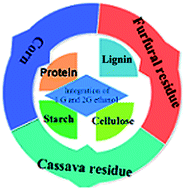Yield-determining components in high-solid integrated first and second generation bioethanol production from cassava residues, furfual residues and corn†
Abstract
Industrial wastes that are well pre-treated during related upstream industrial processes, such as cassava residuals and furfural residuals, are becoming promising feedstocks for producing biofuels. To better use these wastes, an approach must be flexible in their use during biologically based ethanol production. In the current study, three scenarios, including the cellulosic ethanol process, the starchy ethanol process, and the integration of 1 G and 2 G ethanol, were compared for ethanol production from CR, FR, and corn. Compared with the starch ethanol process, the cellulosic ethanol process and integration of 1 G and 2 G ethanol produced ethanol at a higher ethanol concentration and yield. Of the three processes, the integrated process utilized over 75% of polysaccharides when using multiple materials as feedstocks. Protein, cellulose, and starch were yield-determining components in the high-solid integration process. Protein provided important nutrients for yeast cells. The influences of cellulose and starch were associated with product inhibition of cellulases and viscosity. Lignin had a low or negligible influence. For an integration process at a 20% (w/w) substrate loading, the optimum concentrations of protein, cellulose, and starch included >1%, from 4% to 5%, and from 8% to 11%, respectively. At the optimum concentrations, the integration process obtained a final ethanol concentration of about 70 g L−1 and an ethanol yield of about 80%.


 Please wait while we load your content...
Please wait while we load your content...